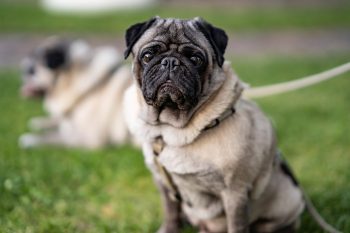Pugs are a delightful and popular small breed known for their charming personalities and distinctive appearance. They make wonderful companions, but like all dogs, they have certain needs, including regular bathroom breaks. In this article, we’ll explore how often you should take your pug outside to pee, considering their age and specific needs. Whether you’re a new pug owner or looking for a refresher, understanding your pug’s bathroom requirements is crucial for their well-being and your peace of mind.
Understanding Pug’s Bladder Capacity
Before diving into age-specific guidelines, it’s essential to understand a pug’s bladder capacity and how it varies based on age. Pugs, like other small breeds, have relatively small bladders compared to larger dogs. This means they have a limited capacity to hold urine, and they may need more frequent bathroom breaks.
Pug puppies have the smallest bladders of all, while adult pugs can hold it a bit longer, and senior pugs may have reduced bladder control. It’s important to keep this in mind when establishing a routine for potty breaks.
Age-Specific Guidelines
Pug Puppies (8 weeks to 6 months):
Pug puppies are incredibly adorable but require the most attention when it comes to potty training. At this age, their bladder and bowel control is limited, and they’ll need to go out frequently. Here’s a guideline for pug puppies:
Every 30 minutes to 1 hour: When your pug puppy is awake and active, take them outside every 30 minutes to 1 hour. Puppies tend to pee shortly after eating, drinking, or waking up from a nap.
After playtime: Puppies are full of energy and excitement, which can stimulate their bladder. Take them outside for a bathroom break after play sessions.
During the night: Be prepared for nighttime bathroom trips as well. Puppies usually can’t hold it through the night, so set an alarm to take them out every 2-3 hours.
Consistency is key when potty training your pug puppy. Reward them with praise and treats when they go outside, reinforcing the positive behavior.
Adult Pugs (6 months to 8 years):
Adult pugs typically have better bladder control than puppies, but they still require regular potty breaks. Here’s a guideline for adult pugs:
Every 2-4 hours: Adult pugs can generally hold their urine for 2-4 hours during the day. This means you should take them out every 2-4 hours, depending on their activity level and individual needs.
After meals and before bedtime: Like puppies, adult pugs may need to go out shortly after eating or before bedtime. Ensure they have a bathroom break within 30 minutes of finishing their meals and before settling down for the night.
Watch for signs: Pay attention to your pug’s cues. If they start pacing, whining, sniffing around, or circling, it’s a sign they need to go out. Respond promptly to avoid accidents indoors.
Consistency remains important with adult pugs as well. Maintain a regular potty schedule and continue to reward good behavior with positive reinforcement.
Senior Pugs (8 years and older):
As pugs age, their bladder control may decline, and they may develop health issues that affect their ability to hold it. Senior pugs require special attention to their bathroom needs. Here’s a guideline for senior pugs:
Every 2-3 hours: Senior pugs may need to go out every 2-3 hours during the day. Keep a close eye on them for signs of discomfort or urgency.
Frequent bathroom breaks: Be prepared for more frequent bathroom breaks, especially if your senior pug has health issues like urinary incontinence or arthritis, which can make it harder for them to hold it.
Easy access: Make sure your senior pug has easy access to the outdoors or a designated potty area. Consider installing a doggie door or using puppy pads if mobility is an issue.
In addition to regular potty breaks, senior pugs may require more frequent veterinary check-ups to address any age-related health concerns that can impact their bathroom habits.
General Tips for Potty Training and Bathroom Breaks
Regardless of your pug’s age, there are some general tips that can help with potty training and managing their bathroom breaks effectively:
Establish a Routine: Dogs thrive on routines. Set a consistent schedule for potty breaks, feeding, and playtime. This helps your pug anticipate when they’ll get a chance to go outside.
Use Positive Reinforcement: Reward your pug with praise, treats, or affection when they do their business outside. This positive reinforcement encourages good behavior.
Supervise Your Pug: Keep a close eye on your pug, especially during potty training. Supervision allows you to catch accidents in the act and redirect them outside.
Be Patient: Potty training can take time, and accidents will happen. Be patient with your pug and avoid scolding them for accidents. Instead, focus on reinforcing good behavior.
Crate Training: Consider crate training your pug, especially during potty training. Dogs are less likely to eliminate in their sleeping area, so a properly sized crate can help prevent accidents when you can’t supervise your pug.
Regular Exercise: Regular exercise helps regulate your pug’s digestive system and can reduce the likelihood of accidents. Make sure your pug gets daily walks and playtime.
Watch for Health Issues: If your pug suddenly starts having accidents indoors or exhibits changes in their bathroom habits, consult with your veterinarian. Underlying health issues could be the cause.
Conclusion: How Often Do I Take a Pug Outside to Pee?
Taking your pug outside to pee at the appropriate frequency is crucial for their comfort, well-being, and your home’s cleanliness. Understanding your pug’s age-specific needs and following a consistent routine can make the potty training process smoother and ensure a happy and healthy life for your beloved pug companion. Remember, patience, positive reinforcement, and attentive care are the keys to successful potty training and happy pug ownership.
The post How Often Do I Take a Pug Outside to Pee? appeared first on iHeartDogs.com.

